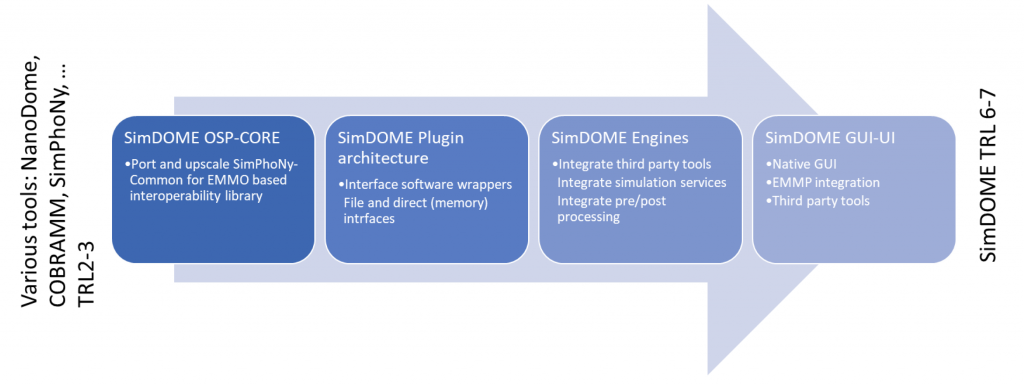Metholodogy
The activities in SimDOME will be firstly oriented to join the development of the EMMO. This will be greatly facilitated by the fact that GCL, FRAUNHOFER and UNIBO are currently part of the lead EMMO development team. It’s important to note that SimDOME will provide the EMMC with more resources to pursue one of its main objectives: the development of an EU community developed materials modelling ontology. SimDOME focuses in addition on extensions of the EMMO to the specific domains covered by the applications. SimDOME partners will interact with other similar projects to support EMMO. In the first year, the aim will be primarily to design the framework software infrastructure. Integration of the EMMO within and upscaling of SimPhoNy-common (as the OSP CORE) will be carried out and suitable data file formats (e.g. XML, JSON, HDF5) will be investigated to enable storing and managing of user cases data and to facilitate data exchange between applications. Design of the API architecture for the GUI and the third-party software will be also pursued.
Active involvement of the software owner SME and the Industrial partners will ensure professional design of the interface that meets industry end user requirements. Limited model development and experimental activity (e.g. data collection) is required for PBE-CFD and COBRAMM to extend the range of materials and processes coverage and increase their industrial impact and uptake. The EMMO will be integrated to cover the knowledge needed to address the SimDOME Applications.
In the first year, the EMMO will also be extended with the chemical kinetic representation made in ONTOKIN. During the second/third years the SimDOME software framework will be developed and implemented. This consists of implementing the engine-side wrapper design elements, i.e. the syntactic parts of the wrappers to all integrated components, including third-party elements. At the same time partners will integrate their existing software within the framework and will develop interfaces for third-party software. Since most of the software to be integrated (i.e. NanoDome, COBRAMM, PBE-CFD) has been developed by academia, some software re-engineering is foreseen to 1) enhance efficiency of the interface wrappers by fine tuning the engine interfaces with minimal code changes and 2) take advantage of existing High-Performance Computing (HPC) hardware and technique.
Alpha release, GUI development and initial integration to the EMMM also take place during the third year of the project. Minimal code changes to integrated software tools enables low maintenance of wrappers due to release cycles of third-party tools.
During the fourth year the beta version of the SimDOME OSP and GUI, together with the Applications modules and software, will be tested in operational environments by the SME/Industrial partners. An iterative approach between testing and development will lead to the final release of the TRL 7 tested framework and the Applications modules.

